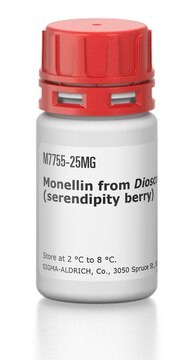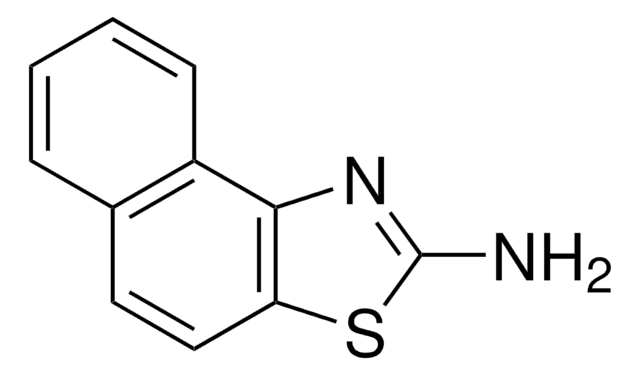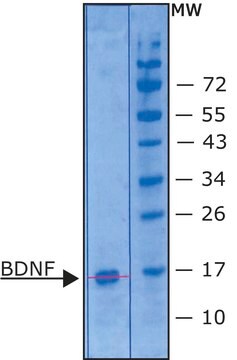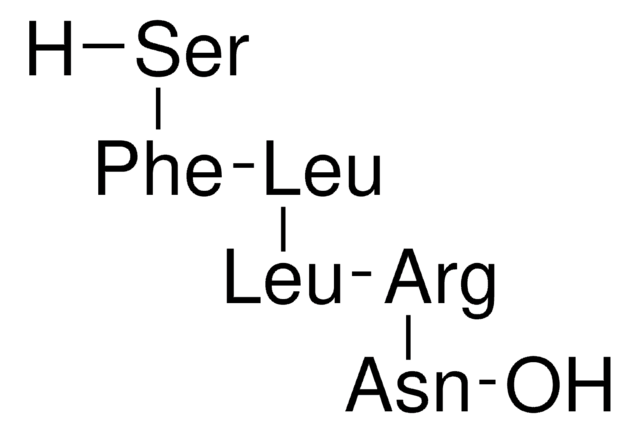SRP2076
Pregnane X receptor (138-434), His tagged human
recombinant, expressed in E. coli, ≥85% (SDS-PAGE)
Synonym(s):
BXR, ONR1, PAR, PAR1, PAR2, PARq, PRR, PXR
Sign Into View Organizational & Contract Pricing
All Photos(1)
About This Item
UNSPSC Code:
12352200
NACRES:
NA.26
Recommended Products
biological source
human
recombinant
expressed in E. coli
Assay
≥85% (SDS-PAGE)
form
frozen liquid
mol wt
~35 kDa
packaging
pkg of 10 μg
storage condition
avoid repeated freeze/thaw cycles
concentration
700 μg/mL
color
clear colorless
NCBI accession no.
UniProt accession no.
shipped in
dry ice
storage temp.
−70°C
Gene Information
human ... NR1I2(8856)
Biochem/physiol Actions
The nuclear pregnane X receptor (PXR; NR1I2) is an important component of the body′s adaptive defense mechanism against toxic substances including foreign chemicals (xenobiotics). PXR is activated by a large number of endogenous and exogenous chemicals including steroids, antibiotics, antimycotics, bile acids, and the herbal antidepressant St. John′s wort. PXR is known to regulate the expression of several additional genes encoding proteins involved in xenobiotic metabolism, including multidrug resistance protein 1 (MDR1) (8,9), multidrug resistance-associated protein 2 (MRP2) (10,11), and organic anion transporter polypeptide 2. Elucidation of the three-dimensional structure of the PXR ligand binding domain revealed that it has a large, spherical ligand binding cavity that allows it to interact with a wide range of hydrophobic chemicals. Thus, unlike other nuclear receptors that interact selectively with their physiological ligands, PXR serves as a generalized sensor of hydrophobic toxins. PXR binds as a heterodimer with the 9-cis retinoic acid receptor (NR2B) to DNA response elements in the regulatory regions of cytochrome P450 3A monooxygenase genes and a number of other genes involved in the metabolism and elimination of xenobiotics from the body.
Physical form
Clear and colorless frozen liquid solution
Preparation Note
Use a manual defrost freezer and avoid repeated freeze-thaw cycles. While working, please keep sample on ice.
Storage Class Code
10 - Combustible liquids
WGK
WGK 1
Flash Point(F)
Not applicable
Flash Point(C)
Not applicable
Choose from one of the most recent versions:
Certificates of Analysis (COA)
Lot/Batch Number
Don't see the Right Version?
If you require a particular version, you can look up a specific certificate by the Lot or Batch number.
Already Own This Product?
Find documentation for the products that you have recently purchased in the Document Library.
P Honkakoski et al.
The Biochemical journal, 347(Pt 2), 321-337 (2000-04-06)
Members of the nuclear-receptor superfamily mediate crucial physiological functions by regulating the synthesis of their target genes. Nuclear receptors are usually activated by ligand binding. Cytochrome P450 (CYP) isoforms often catalyse both formation and degradation of these ligands. CYPs also
D J Waxman
Archives of biochemistry and biophysics, 369(1), 11-23 (1999-08-27)
The biochemistry of foreign compound metabolism and the roles played by individual cytochrome P450 (CYP) enzymes in drug metabolism and in the toxification and detoxification of xenochemicals prevalent in the environment are important areas of molecular pharmacology and toxicology that
G Bertilsson et al.
Proceedings of the National Academy of Sciences of the United States of America, 95(21), 12208-12213 (1998-10-15)
Nuclear receptors regulate metabolic pathways in response to changes in the environment by appropriate alterations in gene expression of key metabolic enzymes. Here, a computational search approach based on iteratively built hidden Markov models of nuclear receptors was used to
Our team of scientists has experience in all areas of research including Life Science, Material Science, Chemical Synthesis, Chromatography, Analytical and many others.
Contact Technical Service








